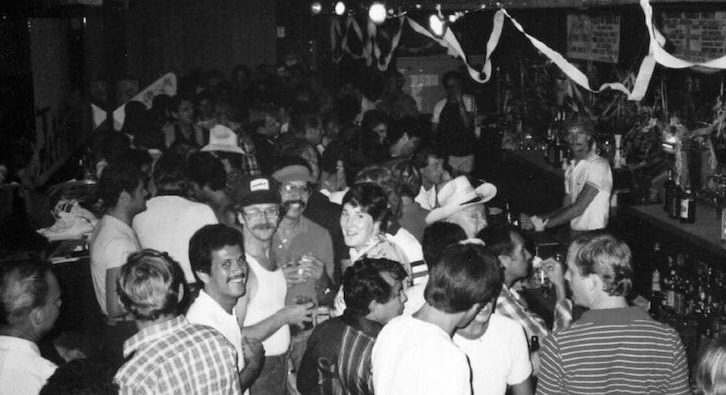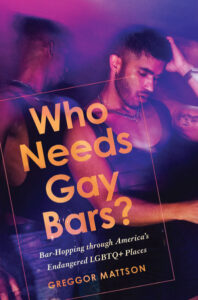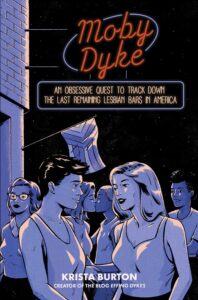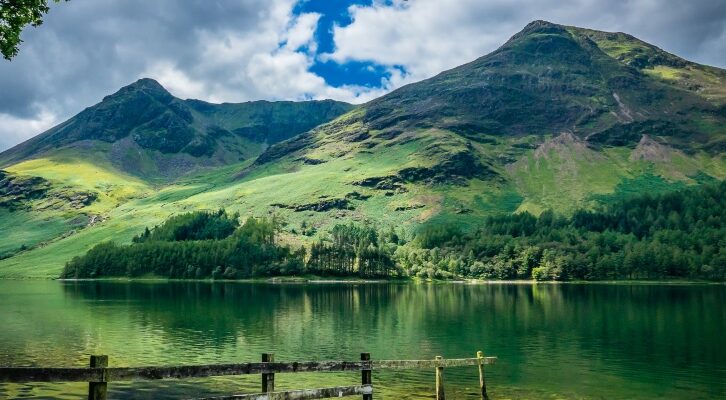
Come Join the Party! Lessons from Visiting Every Gay and Lesbian Bar in the Country
Greggor Mattson and Krista Burton Discuss Their Respective Cross-Country Gay Bar Pilgrimages
When my favorite gay bar closed in Cleveland, coastal folks agreed it was gentrification. That didn’t square with life here in the depopulating rust belt. Straight journalists had called my favorite corner a “toxic” “nowhere;” some gay businessmen called it an improvement. Many locals said that it didn’t matter, as if Cleveland had gay bars to spare— though half had recently closed. I seethed for months, worrying over the fate of gay bars like a sore tooth. I started the morbid Twitter account “Gay bar death watch” where I chronicled gay bar closures around the country.
Then Pulse happened. A murderer gunned down 49 dancers at Latin Night in a gay club in Orlando. I changed my Twitter handle to a question—who needs gay bars?—and set out to one of Cleveland’s surviving gay bars with two Latino friends. We got approached by a local TV news reporter. Marcelo was incandescent with rage at a country with more guns than people and little value on queer life. I said something milquetoast about protecting our LGBTQ+ places. I made the broadcast. There was no place for Latino anger in straight shock and mourning, despite a long queer tradition of us being united in our anger.
It turned out I was mad enough to crisscross the United States over seven years to find out what was happening in gay bars. They are the most common LGBTQ+ place, and in many cities they are the only site for queer cultural forms: gender neutral restrooms, drag shows, Pride celebrations, or amorous glances at the cute person over there without fear of violence. And gay bars are closing fast: more than 45% between 2002 and 2023. By the end of my travels, I had put 10,000 miles on my car, visited nearly 300 bars in 39 states, and talked to hundreds of owners and managers, drag artists and DJs.
Just as I was writing up my project, Krista Burton was on her own project, a pilgrimage to all the lesbian bars in the country. We spoke about our projects, our dreams for LGBTQ+ places, and the challenges of gay bar road trips.
–Greggor Mattson
*
Greggor Mattson: When I first heard about your book I immediately connected with the white whale metaphor of obsessive pursuit. For me, my obsession was fueled by how developers danced on the grave of my favorite gay bar here in Cleveland and the utter lack of information about whether, or where, or why gay bars were closing. What prompted you to embark on your project?
Krista Burton: Everything started in 2015, when the Lexington Club in San Francisco closed. That bar meant a lot to me, and its closure felt personal in a way that I hadn’t experienced before. I spent a couple years noticing more and more lesbian bars closing and yell-complaining about it, and then in 2017, I wrote a piece for the NYT called “I Want My Lesbian Bars Back.”
GM: I cite that article!
KB: No way! Later, in 2021, after a sea of articles in the media had floated around about how there were less than 25 lesbian bars left in the United States, an editor at Simon & Schuster contacted my agent and pitched a book idea that I’d also been thinking about for years: I would go to all the remaining lesbian bars and wrote about what I found.
GM: Luckily, there’s some good news: the number of lesbian bars increased from 2021-2023 to from 15 to 28. Before the recent blossoming of lesbian bars, I used to tease people by asking them to guess which cities had more than one lesbian bar. Everyone would guess New York City, but nobody guessed Oklahoma City. Did you figure out why OKC is a lesbian capital?
KB: I never did, and I still don’t understand, but it’s Oklahoma’s gift to us all. Thank you, Oklahoma!
GM: What would you say were the positive things you learned about lesbian bars? For me, it was how many LGBTQ+ bars are total community anchors, sometimes for the entire community, in rural places, and others, for a part of the community: Black queer folks, for women. What about you?
KB: On my travels, I was surprised by both great things (lesbian bars are so inclusive! Everyone really is welcome! there are so many fun and creative events at them each night!) and funny things (the soundtrack to lesbian bars – mid-2000s jamz – has remained the same since I was in my 20s; even small-town bars have vegan food options; and floppy, middle-parted Jonathan Taylor Thomas-style haircuts are back for queer youth.)
GM: One of the things I was interested in was showing that many gay bars aren’t as inclusive to the breadth and depth of the LGBTQ+ community as they should be, but I also wanted to protect individual bars from online vigilante mobs trashing their Yelp ratings over my exposés of their racism, misogyny, and transphobia. Even so, I hope I provided local communities with the tools to make their spaces into what they want and need. How did you deal with naming people who said things that were transphobic or racist?
KB: This actually never happened to me in the lesbian bars! Any time I was bracing myself for some weird shit to be said in a bar, the person I was talking to absolutely surprised me. Even when I thought someone was about to be a TERF, it never happened. I think because lesbian bars have been forced to become more emphatically inclusive to stay open in a way that gay bars haven’t, people in them have learned they have to accept everyone in their space or get out. What moves are gay bars making to be more inclusive of the queer community? Are they starting to trend the way of lesbian and queer bars, inclusivity-wise?
GM: Queer bars are such an interesting and necessary trend. Some of them aren’t pseudo-lesbian bars, but gay bars that have gone inclusive, so I’d say there’s a convergence there. The fastest declining kind of gay bars over the last two years has been bars that only serve cisgender men, and the fastest growing are bars that serve men and women—the jury is still out on whether they welcome all genders. But you’re absolutely right: lesbian bars went all-gender earlier and more intentionally than many gay bars. Men’s kink bars have been moving in this direction too, which is interesting, given the decline of gender segregation in LGBTQ+ places. Lesbian bars have also managed to welcome straight people while hewing to their mission. Lots of LGBTQ+ places can look to lesbian bars for a model of how to welcome everybody and still support and celebrate one part of the LGBTQ+ community.
KB: OK, gay bars, come join the party!
GM: Exactly! Speaking of parties, everyone asks me “what’s my favorite gay bar” and I always say that’s like asking “what’s your favorite child.” I parry by asking the asker, “what kind of moment do I want to have?” When I want a dancy moment, I go to one bar. When I want an alt-punk drag show, I go to another. When I want a Sunday happy hour, I go to a third. What’s your answer to that question?
I actually don’t have a name for my bar yet, because every time I hear something clever and gay, I go, “That’s the name of my bar.”
KB: I loved all the bars, but I have some notable favorites! The Back Door in Bloomington, IN was one – I saw the best drag show of my life there on a Saturday night in November, and I’ve been going to drag shows for 20 years. Herz in Mobile, AL, which sadly closed in April, offered me the warmest welcome I’ve ever experienced. Sue Ellen’s in Dallas was a CLUB-club; I’d never seen anything like it on the queer bar scene, and I had such a good time there! Alibi’s in Oklahoma City, too – I’d stuff that bar in my pocket if I could. They were playing weed bingo when I visited, and someone had brought chips and homemade queso in a blue-and-white Crockpot to share with everyone! For free!
I had a set number of bars that I wanted to visit, but you were visiting many, many bars across the country. How did you decide you were done with your visits?
GM: My partner made me stop. I was still learning new things! As you well know, LGBTQ+ places are so quirky, and we’re such a fascinating people, that I kept finding new things. But at a certain point after 300 bars, it’s time to share what you’ve learned with others, especially when your partner has been so patient over seven years. But even after I was finished writing things up, I would still squeeze in more interviews, most recently with one of the co-owners of the Fox Bar and Market in East Montpelier Vermont, perhaps the world’s only gay bar where you can also buy cheese and fresh vegetables.
KB: Whoa, I would love to go there. Did you see anything else you’ll never forget?
GM: So many! But I’ll tell you things I heard: servicemembers in their uniforms singing karaoke in Honolulu. Someone bellowing Nine Inch Nails’ “Head Like a Hole” into the night at outdoor karaoke in Johnson City, Tennessee. A drag queen in Oklahoma live-singing Dolly Parton’s “Itty Bitty Pissant Country Place” from Best Little Whorehouse in Texas. Lots of singing and queer joy.
KB: Incredible. At Sue Ellen’s, I saw a young queer do a double-take when a babe sat down next to them, and then I watched them make heavy eye contact with the babe while slowly licking up the neck of a beer bottle. Truly unforgettable. What’s your go-to drink order?
GM: Miller Lite. When I came out in the 90s, we were boycotting Coors and Budweiser for some reason, and so I started drinking Miller Lites. Later, I liked that I could precisely control the amount of alcohol I was ingesting: gay bars have heavy pours of liquor and you never know how you’re going to feel after a simple gin and tonic! And since I’ve long had to drive to and from gay bars, knowing how much alcohol I’ve had is essential to being safe on the roads. But if I’m walking home in my small Ohio town, or someone else is driving, I like a Manhattan. What’s yours?
KB: That is… genius. Because yes, my drink is a gin and tonic, and no, I cannot ever tell how I’ll feel after a single drink. But OK: what would you name your gay bar?
GM: Well. When I first moved to Ohio I bought a 1930s back bar for my apartment from a tavern that went out of business–a back bar is the furniture piece behind the bar counter with the mirrors and the lights and the racks for bottles. I named it after a hustler bar in San Francisco in the Polk Gulch neighborhood back when it used to be gay. The name was: The White Swallow. I’m sure you’re not as tacky as I am. What would be yours?
KB: OH MY GOD I MENTION THE WHITE SWALLOW IN MY BOOK. Alright let me calm down. I actually don’t have a name for my bar yet, because every time I hear something clever and gay, I go, “That’s the name of my bar.” So: undecided! Whatever it is, it will be a filthy pun, I can feel it.
*
Greggor Mattson, PhD, is an author and Professor of Sociology at Oberlin College & Conservatory where he teaches courses on sexuality, nightlife, and cities. He is the author of The Cultural Politics of European Prostitution Reform: Governing Loose Women (2016). His work has appeared in the Annual Review of Sociology, as well as in Slate, Literary Hub, Business Insider, and The Daily Beast.
Krista Burton is the creator of the popular blog Effing Dykes and was a frequent contributor to the online magazine Rookie. Her writing has also appeared in The New York Times, The Guardian, Elle, and VICE. She lives in Minnesota.
____________________________________________

Who Needs Gay Bars? by Greggor Mattson is available now via Stanford University Press.

Moby Dyke by Krista Burton is available now via Simon & Schuster.



















